check engine Hyundai Sonata Plug-in Hybrid 2018 Repair Manual
[x] Cancel search | Manufacturer: HYUNDAI, Model Year: 2018, Model line: Sonata Plug-in Hybrid, Model: Hyundai Sonata Plug-in Hybrid 2018Pages: 552, PDF Size: 18.67 MB
Page 421 of 552
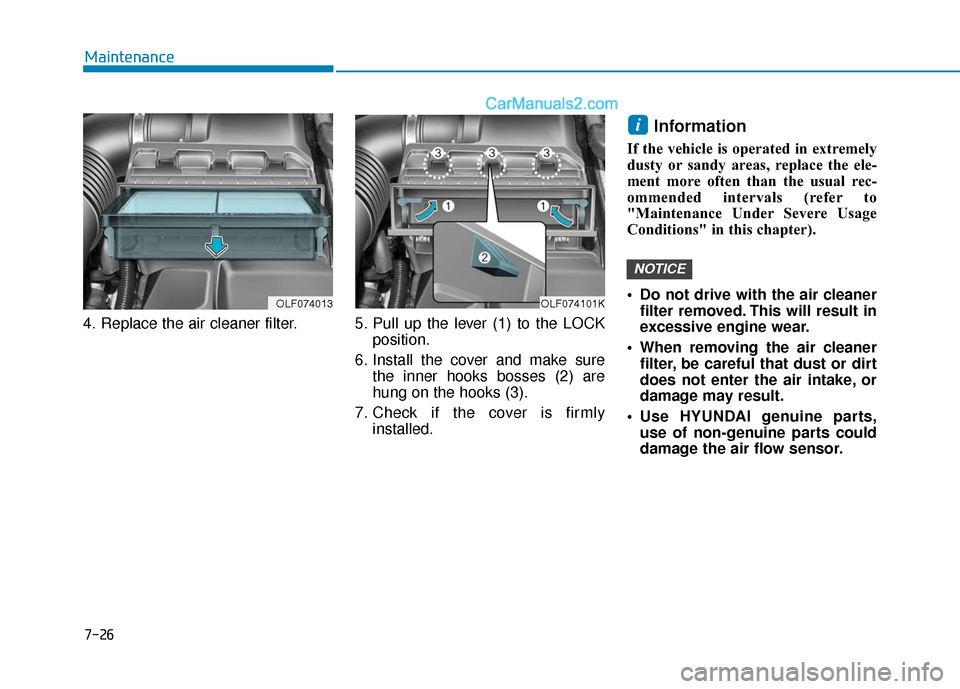
7-26
Maintenance
4. Replace the air cleaner filter. 5. Pull up the lever (1) to the LOCK position.
6. Install the cover and make sure the inner hooks bosses (2) are
hung on the hooks (3).
7. Check if the cover is firmly installed.
Information
If the vehicle is operated in extremely
dusty or sandy areas, replace the ele-
ment more often than the usual rec-
ommended intervals (refer to
"Maintenance Under Severe Usage
Conditions" in this chapter).
Do not drive with the air cleanerfilter removed. This will result in
excessive engine wear.
When removing the air cleaner filter, be careful that dust or dirt
does not enter the air intake, or
damage may result.
Use HYUNDAI genuine parts, use of non-genuine parts could
damage the air flow sensor.
NOTICE
i
OLF074013OLF074101K
Page 427 of 552

7-32
Maintenance
For best battery service Keep the battery securely mounted.
Keep the battery top clean and dry.
Keep the terminals and connec-tions clean, tight, and coated with
petroleum jelly or terminal grease.
Rinse any spilled acid from the bat- tery immediately with a solution of
water and baking soda.Battery recharging
Always follow these instructions
when recharging your vehicle’s
battery to avoid the risk of SERI-
OUS INJURY or DEATH from
explosions or acid burns:
Before performing mainte-
nance or recharging the bat-
tery, turn off all accessories and
place the Engine Start/Stop
button to the OFF position.
Keep all flames, sparks, or
smoking materials away from
the battery.
Always work outdoors or in an
area with plenty of ventilation.
Wear eye protection when
checking the battery during
charging.
The battery must be removed
from the vehicle and placed in
a well ventilated area.
(Continued)
WARNING
OLFH047757
OLFP047757
■Hybrid
■Plug-in hybrid
Page 445 of 552
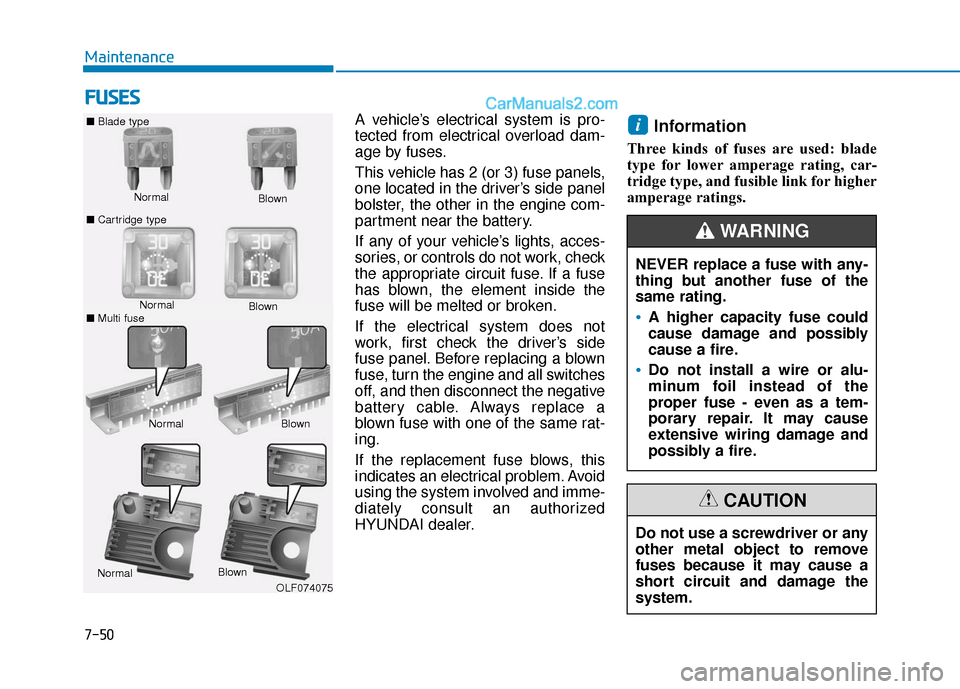
7-50
Maintenance
F
FU
U S
SE
E S
S
A vehicle’s electrical system is pro-
tected from electrical overload dam-
age by fuses.
This vehicle has 2 (or 3) fuse panels,
one located in the driver’s side panel
bolster, the other in the engine com-
partment near the battery.
If any of your vehicle’s lights, acces-
sories, or controls do not work, check
the appropriate circuit fuse. If a fuse
has blown, the element inside the
fuse will be melted or broken.
If the electrical system does not
work, first check the driver’s side
fuse panel. Before replacing a blown
fuse, turn the engine and all switches
off, and then disconnect the negative
battery cable. Always replace a
blown fuse with one of the same rat-
ing.
If the replacement fuse blows, this
indicates an electrical problem. Avoid
using the system involved and imme-
diately consult an authorized
HYUNDAI dealer.Information
Three kinds of fuses are used: blade
type for lower amperage rating, car-
tridge type, and fusible link for higher
amperage ratings.
i
Normal
■
Blade type
■ Cartridge type Blown
Normal Blown
Normal Blown
OLF074075
Do not use a screwdriver or any
other metal object to remove
fuses because it may cause a
short circuit and damage the
system.
CAUTION
NEVER replace a fuse with any-
thing but another fuse of the
same rating.
A higher capacity fuse could
cause damage and possibly
cause a fire.
Do not install a wire or alu-
minum foil instead of the
proper fuse - even as a tem-
porary repair. It may cause
extensive wiring damage and
possibly a fire.
WARNING
Normal Blown
■ Multi fuse
Page 446 of 552
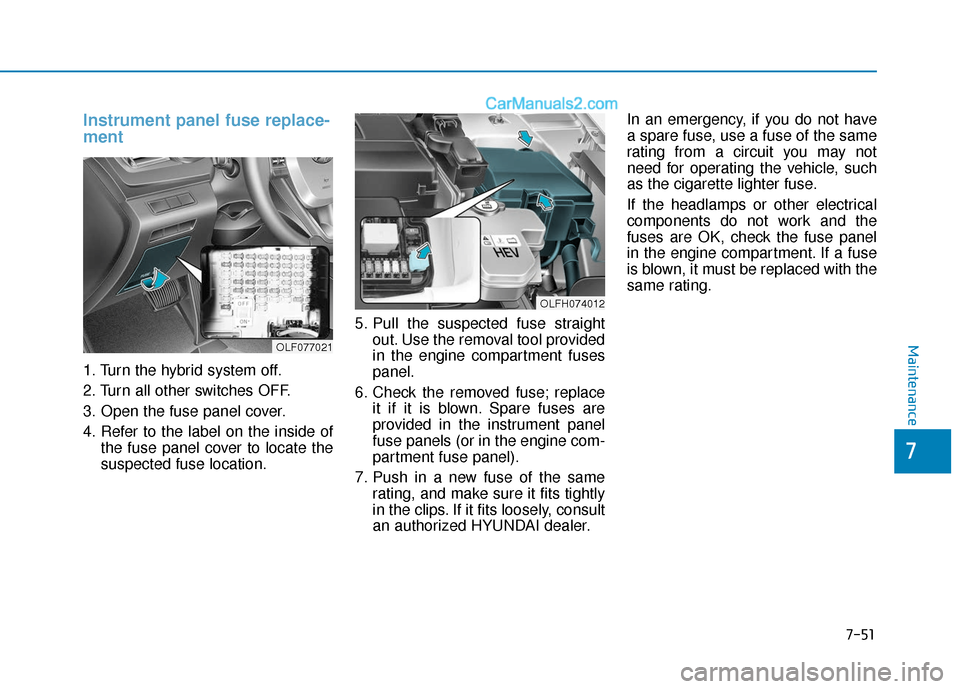
7-51
7
Maintenance
Instrument panel fuse replace-
ment
1. Turn the hybrid system off.
2. Turn all other switches OFF.
3. Open the fuse panel cover.
4. Refer to the label on the inside ofthe fuse panel cover to locate the
suspected fuse location. 5. Pull the suspected fuse straight
out. Use the removal tool provided
in the engine compartment fuses
panel.
6. Check the removed fuse; replace it if it is blown. Spare fuses are
provided in the instrument panel
fuse panels (or in the engine com-
partment fuse panel).
7. Push in a new fuse of the same rating, and make sure it fits tightly
in the clips. If it fits loosely, consult
an authorized HYUNDAI dealer. In an emergency, if you do not have
a spare fuse, use a fuse of the same
rating from a circuit you may not
need for operating the vehicle, such
as the cigarette lighter fuse.
If the headlamps or other electrical
components do not work and the
fuses are OK, check the fuse panel
in the engine compartment. If a fuse
is blown, it must be replaced with the
same rating.
OLF077021
OLFH074012
Page 447 of 552
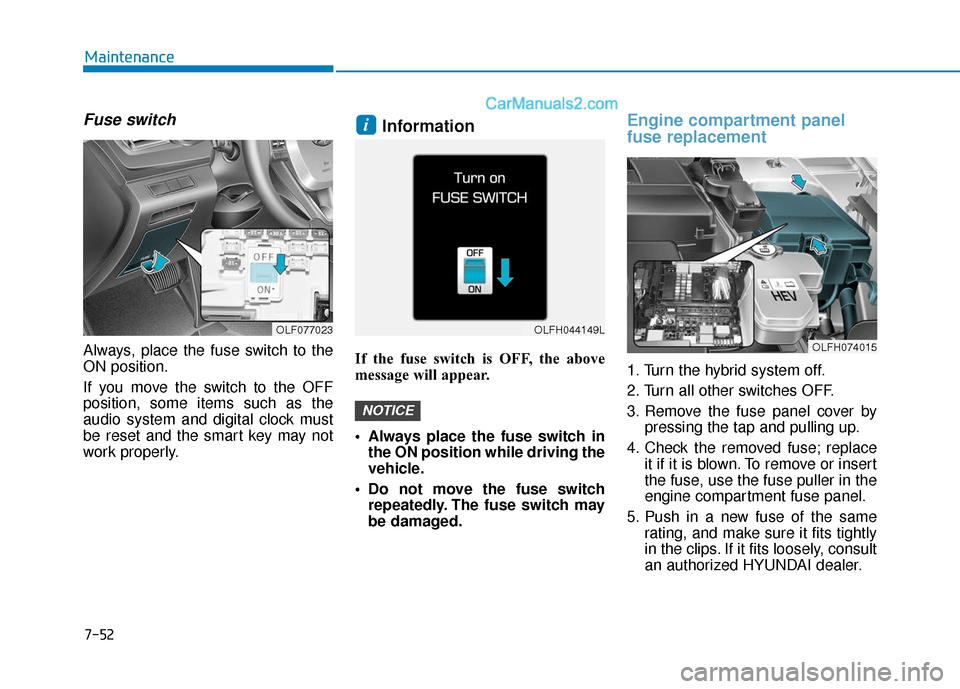
7-52
Maintenance
Fuse switch
Always, place the fuse switch to the
ON position.
If you move the switch to the OFF
position, some items such as the
audio system and digital clock must
be reset and the smart key may not
work properly.
Information
If the fuse switch is OFF, the above
message will appear.
Always place the fuse switch inthe ON position while driving the
vehicle.
Do not move the fuse switch repeatedly. The fuse switch may
be damaged.
Engine compartment panel
fuse replacement
1. Turn the hybrid system off.
2. Turn all other switches OFF.
3. Remove the fuse panel cover by pressing the tap and pulling up.
4. Check the removed fuse; replace it if it is blown. To remove or insert
the fuse, use the fuse puller in the
engine compartment fuse panel.
5. Push in a new fuse of the same rating, and make sure it fits tightly
in the clips. If it fits loosely, consult
an authorized HYUNDAI dealer.
NOTICE
i
OLF077023OLFH044149L
OLFH074015
Page 456 of 552

7-61
7
Maintenance
Engine compartment main fuse panel
Fuse No.Fuse NameFuse RatingCircuit Protected
MULTI FUSE(TYPE A)
IG230APCB Block (IG2 Relay)
BLOWER40ABlower Relay
2AHB40AIntegrated Brake Actuation Unit, Multipurpose Check Connector
1AHB40AIntegrated Brake Actuation Unit, Multipurpose Check Connector
REAR HEATED50ARear Heated Relay
3B+50AIGPM (IPS2 (4CH), IPS3 (4CH), Fuse - STOP LAMP/MODULE 1)
5B+50APCM Block
(Fuse - WIPER1/HORN/BATTERY C/FAN/AMS/TCU1/ECU2/Engine Control Relay)
EEWP60AElectric Water Pump
MDPS 180AMDPS Unit
MULTI FUSE(TYPE B)
IG140APCB Block (IG1Relay)
3POWER
OUTLET40APower Outlet Relay
Page 480 of 552

7-85
7
Maintenance
Canister
Fuel vapors generated inside the fuel
tank are absorbed and stored in the
onboard canister. When the engine is
running, the fuel vapors absorbed in
the canister are drawn into the surge
tank through the purge control sole-
noid valve.
Purge Control Solenoid Valve(PCSV)
The purge control solenoid valve is
controlled by the Engine Control
Module (ECM); when the engine
coolant temperature is low during
idling, the PCSV closes so that evap-
orated fuel is not taken into the
engine. After the engine warms-up
during ordinary driving, the PCSV
opens to introduce evaporated fuel to
the engine.
3. Exhaust emission control system
The Exhaust Emission Control
System is a highly effective system
which controls exhaust emissions
while maintaining good vehicle per-
formance.
When the engine starts or fails to
start, excessive attempts to restart
the engine may cause damage to the
emission system.
Vehicle modifications
This vehicle should not be modi-
fied. Modification of your vehicle
could affect its performance, safety
or durability and may even violate
governmental safety and emis-
sions regulations.
In addition, damage or performance
problems resulting from any modifi-
cation may not be covered under
warranty.
If you use unauthorized electronic devices, it may cause the vehicle to
operate abnormally, wire damage,
battery discharge and fire. For your
safety, do not use unauthorized
electronic devices.
Engine exhaust (carbon monox-ide) precautions
Carbon monoxide can be present
with other exhaust fumes. If you
smell exhaust fumes of any kind in
your vehicle, drive with all the win-
dows fully open. Have your vehicle
checked and repaired immediately.
Engine exhaust gases contain
carbon monoxide (CO). Though
colorless and odorless, it is
dangerous and could be lethal if
inhaled. Follow the instructions
on this page to avoid CO poi-
soning.
WARNING
Page 490 of 552
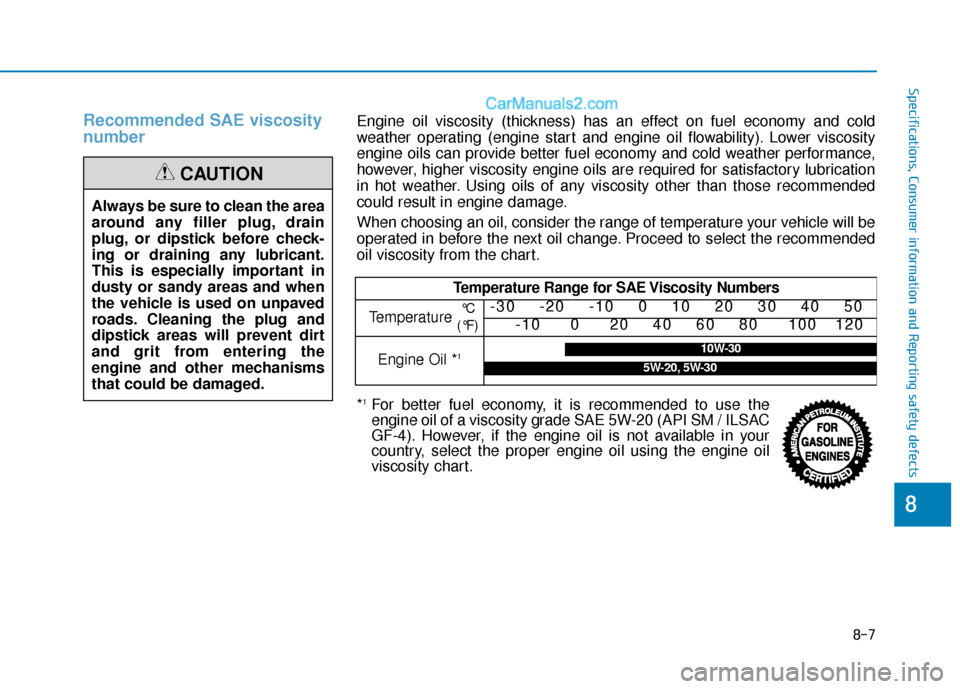
8-7
88
Specifications, Consumer information and Reporting safety defects
Recommended SAE viscosity
number
Always be sure to clean the area
around any filler plug, drain
plug, or dipstick before check-
ing or draining any lubricant.
This is especially important in
dusty or sandy areas and when
the vehicle is used on unpaved
roads. Cleaning the plug and
dipstick areas will prevent dirt
and grit from entering the
engine and other mechanisms
that could be damaged.
CAUTION
Engine oil viscosity (thickness) has an effect on fuel economy and cold
weather operating (engine start and engine oil flowability). Lower viscosity
engine oils can provide better fuel economy and cold weather performance,
however, higher viscosity engine oils are required for satisfactory lubrication
in hot weather. Using oils of any viscosity other than those recommended
could result in engine damage.
When choosing an oil, consider the range of temperature your vehicle will be
operated in before the next oil change. Proceed to select the recommended
oil viscosity from the chart.
Temperature Range for SAE Viscosity Numbers
Temperature -30 -20 -10 0 10 20 30 40 50
-10 0 20 40 60 80 100 120
Engine Oil *110W-30
5W-20, 5W-30
°C
(°F)
*1For better fuel economy, it is recommended to use the
engine oil of a viscosity grade SAE 5W-20 (API SM / ILSAC
GF-4). However, if the engine oil is not available in your
country, select the proper engine oil using the engine oil
viscosity chart.
Page 498 of 552

I-4
Driver assist system ......................................................3-119Rear parking assist system .......................................3-120
Rear parking assist system precautions....................3-123
Rear view camera .....................................................3-119
Driver attention alert system (DAA) ..............................5-63 Resetting the system ...................................................5-65
System malfunction ....................................................5-65
System setting and activation .....................................5-63
System standby...........................................................5-65
Driver position memory system .....................................3-14 Easy Access Function .................................................3-15
Storing Positions into Memory ..................................3-14
Driving the Hybrid/Plug-in Hybrid Vehicle ....................H22 Changing plug-in hybrid mode ...................................H26
Energy flow.................................................................H38
Hybrid system gauge ..................................................H24
Special features ...........................................................H23
Starting the vehicle .....................................................H22
Warning and indicator lights.......................................H27
Warning messages.......................................................H28 Emission control system .................................................7-84
Crankcase emission control system ...........................7-84
Evaporative emission control system including onboard refueling vapor recovery (ORVR) ............7-84
Exhaust emission control system ...............................7-85
Engine ........................................................................\
.......8-2
Engine compartment..................................................1-6, 7-3
Engine coolant/inverter coolant ......................................7-19 Changing engine coolant ............................................7-22
Checking the engine/inverter coolant level................7-19
Engine number ..................................................................8-9
Engine oil ........................................................................\
7-17 Checking the engine oil and filter ..............................7-18
Checking the engine oil level .....................................7-17
Engine Start/Stop button ...................................................5-5 Engine Stop/Start button positions ...............................5-7
Illuminated Engine Start/Stop button ...........................5-6
Starting the hybrid system............................................5-9
Explanation of scheduled maintenance items.................7-14
Exterior features..............................................................3-46 Fuel Filler Door (Hybrid) ...........................................3-53
Fuel Filler Door (Plug-in hybrid) ...............................3-56
Hood ........................................................................\
...3-46
Smart Trunk ................................................................3-50
Trunk ........................................................................\
..3-47
Index
E
Page 499 of 552

I-5
Exterior overview (I) ........................................................1-2
Exterior overview (II) .......................................................1-3
Fuses ........................................................................\
.......7-50Engine compartment panel fuse replacement ............7-52
Fuse/relay panel description .......................................7-54
Instrument panel fuse replacement.............................7-51
Hazard warning flasher .....................................................6-2
HEV (Hybrid electric vehicle) system ..............................H2 Hybrid Vehicle ..............................................................H2
Hybrid starter & generator (HSG) belt ...........................7-22 Checking the hybrid starter & generator (HSG) belt .7-22 If an accident occurs .......................................................6-34
If the engine overheats ......................................................6-7
If the vehicle will not start ................................................6-3
If the engine turns over normally but doesn't start ......6-3
If you have a flat tire ......................................................6-15 With tire mobility kit - Type A...................................6-15
With tire mobility kit - Type B...................................6-22
Important Safety Precautions............................................2-2 Air Bag Hazards ...........................................................2-2
Always Wear Your Seat Belt ........................................2-2
Control Your Speed ......................................................2-3
Driver Distraction.........................................................2-2
Keep Your Vehicle in Safe Condition ..........................2-3
Restrain All Children....................................................2-2
In case of an emergency while driving .............................6-2 If the vehicle stalls at a crossroad or crossing .............6-2
If the vehicle stalls while driving .................................6-2
If you have a flat tire while driving .............................6-3
Instrument cluster ...........................................................3-60 Gauges ........................................................................\
3-63
Instrument cluster control ..........................................3-62
Warning and indicator lights ......................................3-67
Warning messages ......................................................3-81
Instrument panel overview ...............................................1-5
I
Index
F
H
I